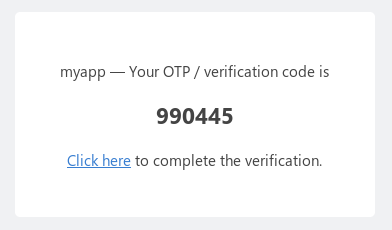 Documentation
¶
Documentation
¶
Index ¶
Constants ¶
This section is empty.
Variables ¶
View Source
var ErrNotExist = errors.New("the OTP does not exist")
ErrNotExist is thrown when an OTP (requested by namespace / ID) does not exist.
Functions ¶
This section is empty.
Types ¶
type NewProvider ¶
NewProvider represents an initialisation function that takes an arbitrary JSON encoded configuration set and returns an instance of a Provider.
type OTP ¶
type OTP struct {
Namespace string `redis:"namespace" json:"namespace"`
ID string `redis:"id" json:"id"`
To string `redis:"to" json:"to"`
ChannelDesc string `redis:"channel_description" json:"channel_description"`
AddressDesc string `redis:"address_description" json:"address_description"`
Extra json.RawMessage `redis:"extra" json:"extra"`
Provider string `redis:"provider" json:"provider"`
OTP string `redis:"otp" json:"otp"`
MaxAttempts int `redis:"max_attempts" json:"max_attempts"`
Attempts int `redis:"attempts" json:"attempts"`
Closed bool `redis:"closed" json:"closed"`
TTL time.Duration `redis:"-" json:"-"`
TTLSeconds float64 `redis:"-" json:"ttl"`
}
OTP contains the information about an OTP.
type Provider ¶
type Provider interface {
// ID returns the name of the Provider.
ID() string
// ChannelName returns the name of the channel the provider is
// validating, for example "SMS" or "E-mail". This is displayed on
// web views.
ChannelName() string
// ChannelDesc returns the help text that is shown to the end users describing
// how the Provider handles OTP verification.
// Eg: "We've sent a 6 digit code to your phone. Enter that here to verify
// your phone number"
ChannelDesc() string
// AddressName returns the name or label of the address for this provider.
// For example "E-mail" for an e-mail provider or "Phone number" for an SMS provider.
AddressName() string
// AddressDesc returns the help text that is shown to the end users when
// they're asked to enter their addresses (eg: e-mail or phone), if the OTP
// registered without an address.
AddressDesc() string
// ValidateAddress validates the 'to' address the Provider
// is supposed to send the OTP to, for instance, an e-mail
// or a phone number.
ValidateAddress(to string) error
// Push pushes a message. Depending on the the Provider,
// implementation, this can either cause the message to
// be sent immediately or be queued waiting for a Flush().
Push(to, subject string, body []byte) error
// MaxAddressLen returns the maximum allowed length of the 'to' address.
MaxAddressLen() int
// MaxOTPLen returns the maximum allowed length of the OTP value.
MaxOTPLen() int
// MaxBodyLen returns the maximum permitted length of the text
// that can be sent by the Provider.
MaxBodyLen() int
}
Provider is an interface for a generic messaging backend, for instance, e-mail, SMS etc.
type ProviderConf ¶
type ProviderConf struct {
Template string `mapstructure:"template"`
Subject string `mapstructure:"subject"`
Config string `mapstructure:"config"`
}
ProviderConf represents the common confoguration types for a Provider.
type RedisConf ¶
type RedisConf struct {
Host string `mapstructure:"host"`
Port int `mapstructure:"port"`
Username string `mapstructure:"username"`
Password string `mapstructure:"password"`
MaxActive int `mapstructure:"max_active"`
MaxIdle int `mapstructure:"max_idle"`
Timeout time.Duration `mapstructure:"timeout"`
KeyPrefix string `mapstructure:"key_prefix"`
}
RedisConf contains Redis configuration fields.
type Store ¶
type Store interface {
// Set sets an OTP against an ID. Every Set() increments the attempts
// count against the ID that was initially set.
Set(namespace, id string, otp OTP) (OTP, error)
// SetAddress sets (updates) the address on an existing OTP.
SetAddress(namespace, id, address string) error
// Check checks the attempt count and TTL duration against an ID.
// Passing counter=true increments the attempt counter.
Check(namespace, id string, counter bool) (OTP, error)
// Close closes an OTP and marks it as done (verified).
// After this, the OTP has to expire after a TTL or be deleted.
Close(namespace, id string) error
// Delete deletes the OTP saved against a given ID.
Delete(namespace, id string) error
}
Store represents a storage backend where OTP data is stored.
func NewRedisStore ¶
NewRedisStore returns a Redis implementation of store.
Click to show internal directories.
Click to hide internal directories.


